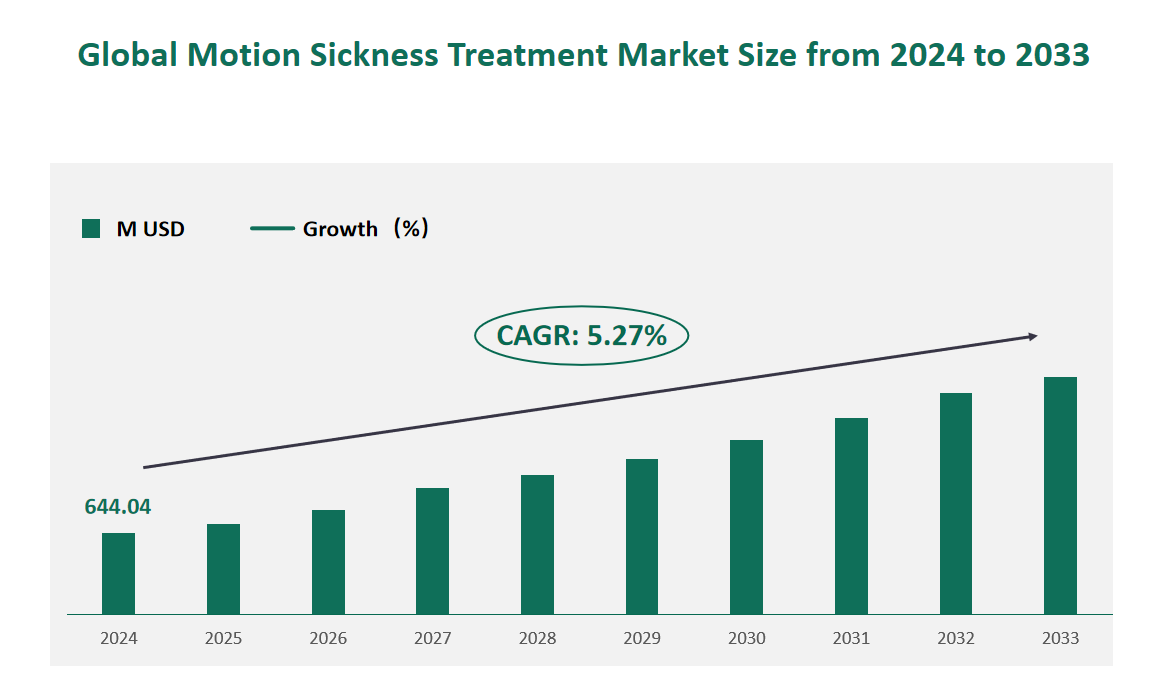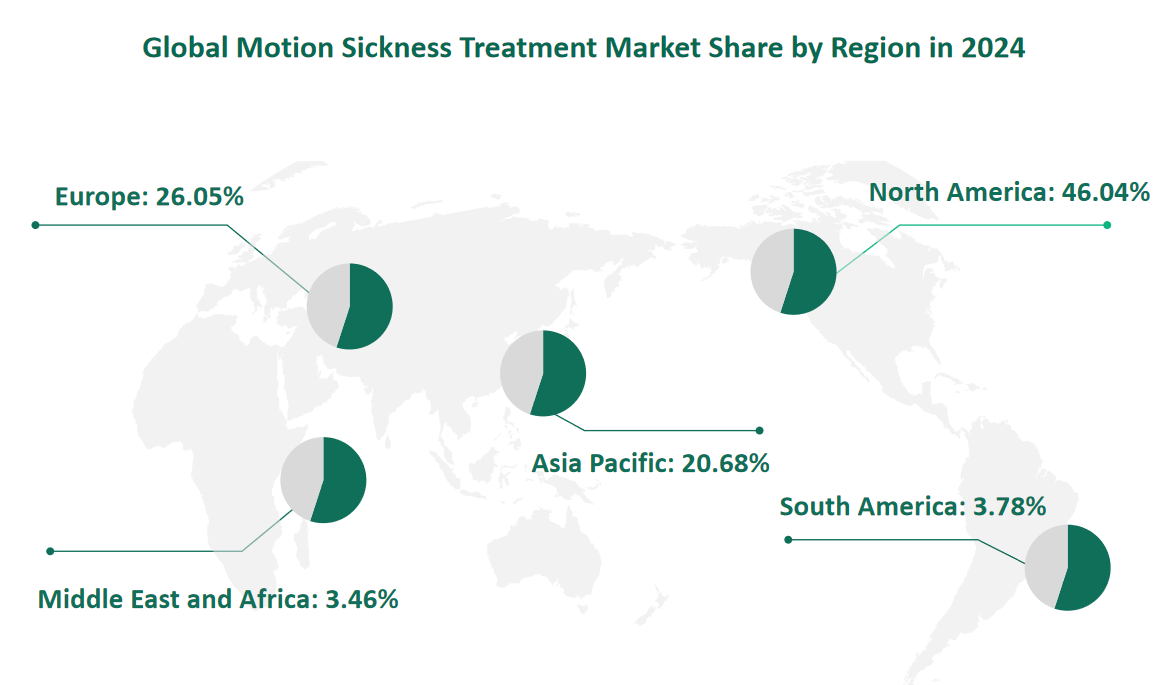1 Global Motion Sickness Treatment Market Size (Value) and CAGR (2024-2033)
In 2024, the global Motion Sickness Treatment market was valued at USD 644.04 million, with a CAGR of 5.27% from 2024 to 2033.
Motion sickness occurs when the brain receives conflicting information from the inner ear, eyes, and nerves in the joints and muscles. Motion Sickness often presents symptoms such as dizziness, nausea, cold sweats, and vomiting. Motion Sickness Treatment refers to products that provide the prevention or relief of motion sickness.
Figure Global Motion Sickness Treatment Market Size (M USD) and CAGR 2024-2033

2 Motion Sickness Treatment Market Drivers
Increasing Number of Global Travelers
Travel is a major contributor to the incidence of motion sickness. As people’s income levels rise and living standards improve, the scale of the tourism market has expanded dramatically. The United Nations World Tourism Organization (UNWTO) reported that the number of international tourists increased from 25 million in 1950 to 1.4 billion in 2018. This trend is expected to continue, with more people traveling for both business and leisure. The increase in travel means more people are exposed to various modes of transportation, such as cars, boats, and airplanes, which can trigger motion sickness. Consequently, the demand for motion sickness treatments is on the rise.
Development of Modern Transportation
The continuous development of the transportation industry has made travel more accessible and frequent. With economic globalization, many companies operate across countries and regions, requiring employees to travel long distances. This increased use of transportation raises the likelihood of experiencing motion sickness. VR users often experience symptoms due to the conflicting signals sent to the brain by the eyes and the body’s sensory organs. This has further expanded the market for motion sickness treatments.
Growing Demand for Effective Treatments
As the number of people affected by motion sickness increases, there is a growing demand for effective and convenient treatments. Traditional medications such as dimenhydrinate and scopolamine are commonly used, but there is a push for more advanced formulations. Sustained and controlled-release drugs, which offer longer-lasting effects and fewer doses, are becoming more popular. These advancements in pharmaceutical technology are expected to drive market growth by providing better solutions for consumers.
3 Motion Sickness Treatment Market Restraints
Side Effects of Current Medications
One of the primary challenges in the motion sickness treatment market is the side effects associated with current medications. Commonly used drugs like dimenhydrinate can cause drowsiness, inability to concentrate, and other adverse reactions. Scopolamine, another popular treatment, can lead to side effects such as thirst, blurred vision, palpitations, and headache. These side effects can limit the use of these medications, especially for individuals who need to remain alert during travel. The development of new treatments with fewer side effects is a critical area of research and development for companies in this market.
High R&D Costs
The pharmaceutical industry is characterized by high research and development (R&D) costs. Developing new drugs involves extensive preclinical studies, clinical trials, and regulatory approvals, which can take up to 10 to 15 years and require significant financial investment. For motion sickness treatments, the need to develop new formulations with fewer side effects and better efficacy adds to the complexity and cost of R&D. This financial burden can be a significant challenge for companies, especially smaller ones, and can limit the number of new products entering the market.
4 Global Motion Sickness Treatment Market Size and Share by Type in 2024
Anticholinergics are a significant segment of the Motion Sickness Treatment market. These medications work by reducing parasympathetic excitability, which helps in alleviating symptoms such as nausea and vomiting associated with motion sickness. In 2024, the Anticholinergics segment is projected to have a market value of $233.46 million. This type includes drugs like scopolamine, which are commonly used in transdermal patches. Scopolamine patches are particularly effective for long-term prevention of motion sickness symptoms, making them a popular choice for travelers and individuals prone to severe motion sickness.
Antihistamines are another crucial segment in the Motion Sickness Treatment market. These drugs exert their anti-motion sickness effects by acting on the vestibular and emesis centers in the brain, blocking the excitation of cholinergic synaptic impulses in the vestibular nucleus. In 2024, the Antihistamines segment is expected to have a market value of $310.93 million. Common antihistamines used for motion sickness include dimenhydrinate and diphenhydramine. These medications are available in various forms, such as tablets and syrups, and are widely used due to their effectiveness and availability over-the-counter. Antihistamines are particularly popular for their ability to provide quick relief from symptoms like dizziness and nausea.
Table Global Motion Sickness Treatment Market Size and Share by Type in 2024
Type | Market Size (M USD) 2024 | Market Share 2024 |
Anticholinergic | 233.46 | 36.25% |
Antihistamines | 310.93 | 48.28% |
Others | 99.65 | 15.47% |
5 Global Motion Sickness Treatment Market Size and Share by Application in 2024
Hospitals play a crucial role in the distribution of motion sickness treatments, particularly for severe cases that require medical intervention. In 2024, the Hospitals segment is projected to have a market value of $267.21 million. This segment includes the use of motion sickness treatments in emergency departments, surgical units, and other hospital settings where patients may experience symptoms related to motion sickness. The treatments provided in hospitals are often more advanced and tailored to specific medical conditions, ensuring effective management of symptoms.
Clinics are another significant application area for motion sickness treatments. These settings provide a more accessible and convenient option for patients seeking relief from motion sickness symptoms. In 2024, the Clinics segment is expected to have a market value of $52.92 million. Clinics often offer a range of over-the-counter and prescription medications, making them a popular choice for individuals who prefer a more personalized approach to managing their symptoms. The growth of this segment is driven by the increasing number of people seeking preventive care and the convenience of accessing treatments without the need for hospital visits.
Pharmacies are the most common distribution channel for motion sickness treatments, offering a wide range of over-the-counter options. In 2024, the Pharmacies segment is projected to have a market value of $254 million. Pharmacies play a vital role in providing consumers with easy access to motion sickness treatments, including antihistamines, anticholinergics, and other formulations. The convenience of purchasing these treatments directly from pharmacies makes them a preferred choice for many travelers and individuals prone to motion sickness. The growth of this segment is driven by the increasing demand for readily available and effective treatments.
Table Global Motion Sickness Treatment Market Size and Share by Application in 2024
Application | Market Size (M USD) 2024 | Market Share 2024 |
Hospitals | 267.21 | 41.49% |
Clinics | 52.92 | 8.22% |
Pharmacy | 254.00 | 39.44% |
Others | 69.91 | 10.86% |
6 Global Motion Sickness Treatment Market Size by Region in 2024
North America is the largest market for Motion Sickness Treatment, driven by the high demand for effective and convenient treatments. In 2024, the North America segment is projected to have a market value of $296.5 million. The United States is the primary driver of this market, with a strong presence of major pharmaceutical companies and a high demand for over-the-counter and prescription medications. The market share of North America is projected to be 46.04% in 2024, making it the largest regional market.
Europe is another significant market for Motion Sickness Treatment, with a strong focus on healthcare and pharmaceutical innovation. In 2024, the Europe segment is expected to have a market value of $167.75 million. Countries such as Germany, the UK, France, and Italy are major contributors to this market, with a high demand for advanced and effective treatments. The market share of Europe is projected to be 26.05% in 2024, driven by the increasing number of travelers and the need for reliable motion sickness treatments.
The Asia-Pacific region is the fastest-growing market for Motion Sickness Treatment, driven by economic development and increasing consumer demand. In 2024, the Asia-Pacific segment is projected to have a market value of $133.19 million. China and Japan are the primary drivers of this market, with a growing number of domestic and international travelers. The market share of the Asia-Pacific region is projected to be 20.68% in 2024, driven by the increasing demand for effective and affordable treatments.
Figure Global Motion Sickness Treatment Market Share by Region in 2024

7 Major Players in Global Motion Sickness Treatment Market
7.1 Prestige Brands
Company Profile:
Prestige Brands is an American company that specializes in the sale and distribution of over-the-counter healthcare and household cleaning products. Established in 1996, Prestige Brands has a strong presence in North America and is known for its focus on product innovation and quality in the OTC healthcare category.
Business Overview:
Prestige Brands operates in various segments, including digestive health, eyes, ears, nose and throat, oral care, and pain relief. The company’s strategy involves acquiring and growing well-known consumer brands, leveraging its extensive distribution network, and expanding its product offerings through innovation and strategic partnerships.
Product Introduction:
One of Prestige Brands’ flagship products in the Motion Sickness Treatment market is Dramamine® Long Lasting. This product provides up to 24 hours of prevention and relief from nausea, dizziness, and vomiting associated with motion sickness. It is specially formulated for long-lasting effectiveness and is recommended to be taken one hour before travel.
Recent Financial Data:
In the most recent year, Prestige Brands reported a revenue of $85.44 million from its Motion Sickness Treatment products.
7.2 Baxter International
Company Profile:
Baxter International, founded in 1931, is a global leader in the development, manufacturing, and marketing of a broad portfolio of essential healthcare products. The company is headquartered in the United States and operates in various segments, including acute and chronic dialysis therapies, sterile intravenous solutions, and surgical hemostat and sealant products.
Business Overview:
Baxter International’s business strategy focuses on innovation, strategic acquisitions, and expanding its product portfolio to meet the evolving needs of healthcare providers and patients. The company’s extensive R&D efforts aim to develop new and improved treatments for various medical conditions, including motion sickness.
Product Introduction:
Baxter International’s Transderm Scop is a notable product in the Motion Sickness Treatment market. This skin patch is used to prevent nausea and vomiting associated with motion sickness or recovery from anesthesia and surgery. The patch works by correcting an imbalance of natural substances in the brain and blocking certain signals that cause nausea and vomiting.
Recent Financial Data:
In the most recent year, Baxter International reported a revenue of $88.23 million from its Motion Sickness Treatment products.
7.3 GlaxoSmithKline
Company Profile:
GlaxoSmithKline (GSK) is a leading global pharmaceutical, biological, and healthcare company. Established in 2000, GSK is headquartered in the United Kingdom and operates in various segments, including anti-infective, central nervous system, respiratory, gastroenterology/metabolism, oncology, and vaccines.
Business Overview:
GSK’s business strategy emphasizes innovation, R&D, and the development of new treatments to address unmet medical needs. The company’s extensive portfolio includes leading oral healthcare products, nutritional beverages, and over-the-counter medications. GSK’s commitment to R&D and strategic partnerships has enabled it to maintain a strong market presence and drive growth in the healthcare sector.
Product Introduction:
GSK’s Joy Rides tablets are a popular product in the Motion Sickness Treatment market. These chewable, fruit-flavored tablets are designed to prevent and treat travel sickness in children and adults. Joy Rides tablets contain hyoscine hydrobromide, which is effective in preventing and treating motion sickness symptoms.
Recent Financial Data:
In the most recent year, GSK reported a revenue of $70.89 million from its Motion Sickness Treatment products.

